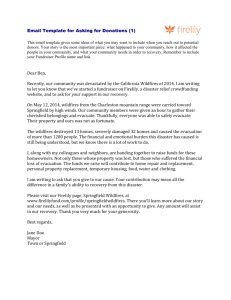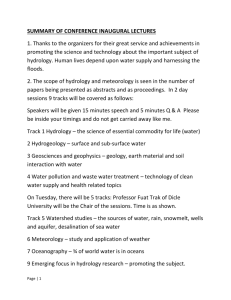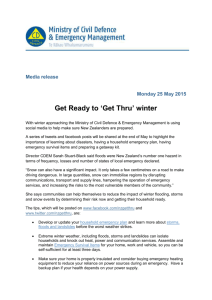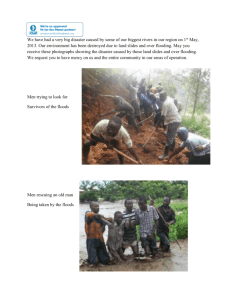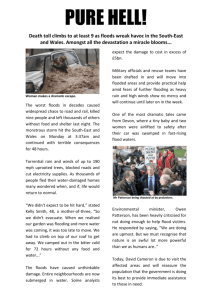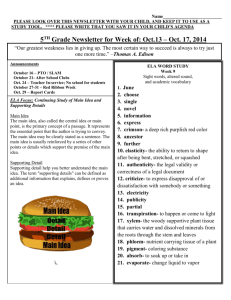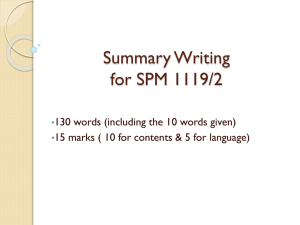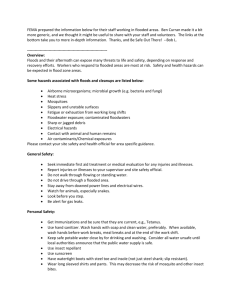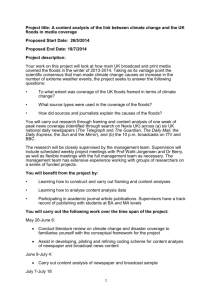Water: Floods, Droughts and Wildfires
advertisement
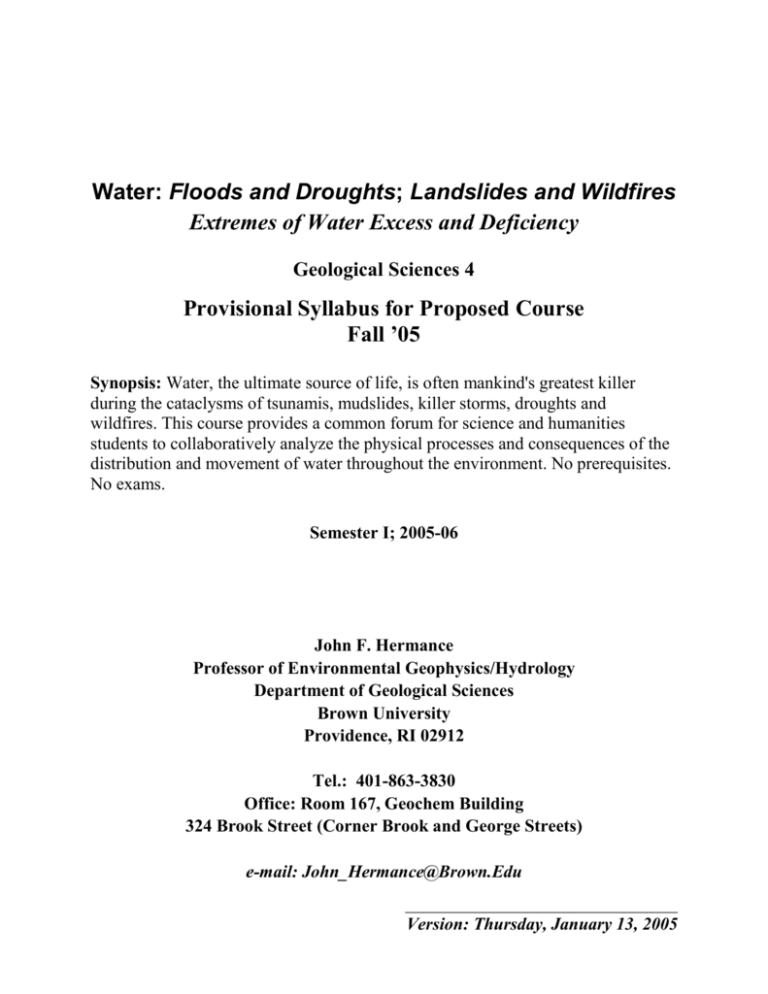
Water: Floods and Droughts; Landslides and Wildfires Extremes of Water Excess and Deficiency Geological Sciences 4 Provisional Syllabus for Proposed Course Fall ’05 Synopsis: Water, the ultimate source of life, is often mankind's greatest killer during the cataclysms of tsunamis, mudslides, killer storms, droughts and wildfires. This course provides a common forum for science and humanities students to collaboratively analyze the physical processes and consequences of the distribution and movement of water throughout the environment. No prerequisites. No exams. Semester I; 2005-06 John F. Hermance Professor of Environmental Geophysics/Hydrology Department of Geological Sciences Brown University Providence, RI 02912 Tel.: 401-863-3830 Office: Room 167, Geochem Building 324 Brook Street (Corner Brook and George Streets) e-mail: John_Hermance@Brown.Edu _______________________________ Version: Thursday, January 13, 2005 Water: Floods and Droughts; Landslides and Wildfires COURSE DESCRIPTION The distribution and behavior of water in the global environment has a multitude of intersecting facets. Fundamentally, of course, is the need to protect and supply clean drinking water for the world’s population. However, throughout human history water has not only been the ultimate source of life, it has often been mankind's greatest killer, impacting entire cultures through the cataclysms of killer storms, floods, droughts, mud slides and wildfires. Which is the worst of these catastrophes? It clearly depends on where you are standing! Californians are beset with mudslides one season, wildfires the next, while a sudden tsunami seizes the public’s attention worldwide. However, far more insidious killers are droughts. In Bengal, India, from the early British colonial era (circa 1750) to 1900, famines either from the failure of the monsoons to bring sufficient rain, or from crop damage resulting from too much rain, have killed more than 13 million people. In 1921-22, in the breadbasket of the newly-formed Soviet Union, a drought in southern Russia and the Ukraine led to a famine in which 5 million people are estimated to have died. In 1928-29, in China a drought-caused famine killed 3 million people. Today, in the Sudan, millions of Africans are threatened by civil strife driven by cultural differences fueled by drought. The impact of water scarcity is manifest in many ways. Wildfires have been sources of catastrophic conflagrations since prehistory, and are an increasing menace as suburban populations encroach on the world’s outback. Annually, in North America, hundreds of thousands of acres are burned and thousands of homes are destroyed causing many hundreds of millions of dollars of economic damage. Then, during heavy deluges from El Nino driven storms, burned-over areas become killing fields for mudslides and flooding. Sickness and mortality is endemic in the majority of the world’s population due to inadequate and disease-ridden water supplies in water-scarce countries. While, in the minds of westerners, this is an issue most often associated with the third world, water quality is a home-grown issue in developed countries as well. Many US water supplies are becoming stressed by over-use; and/or polluted with more than trace amounts of PCBs, MBEs, pesticides, fertilizers and even prescription drugs. Our nation has a marvelous tradition for bringing forth fruit from deserts, at the expense of choking our rivers with dams, and turning the livelihood of fishermen into the dry land culture of fish farms. But wait, … what is this that the diet-conscious public should not eat fish more than twice a week, because the fish farm ponds themselves are laden with carcinogens? Or are they? But water-deficiency is not the only issue too much water can be devastating as well. The storm surge, flooding and winds from a “predicted” monsoonal cyclone in the Bengal Sea of India killed over 300,000 people in Bangladesh in a few hours in 1970. In 2004 and early 2005, while the coastlines of the Indian Ocean recovered from a major tsunami, California and the Western US were wracked with storms; and heavy rains and melting snows caused devastating floods along the Ohio River in the East. Associated with excess water is mass wasting: mud slides and debris flows. The catastrophic movement of unstable earth material is perhaps the most underestimated global hazard. It can happen anywhere! Landslides in the United States, alone, cause at least $1 billion to $2 billion in economic losses annually. This course provides a common forum for students in the sciences and humanities to collaboratively analyze the physical processes associated with both the beneficial and the catastrophic aspects of water in the environment. At one level, we want to explore issues of water sufficiency and the implications of science for good management procedures. On another level, we want to understand the causes and behavior of various natural water-related phenomena, ranging from the percolation of groundwater through a watershed to El Niño’s global scale teleconnections between the oceans and atmosphere. On a third level, we want to assess the impact of water-related catastrophes on mankind, and discuss the prospects for the national and international community to predict and mitigate their effects. To do so, students will engage in a semester-long, interactive dialogue on issues, solutions and consequences, while drawing on an evolving understanding of how water, due to its unique character and interaction with the sun and earth, transports energy and mass through the environment – sometimes the benefactor, sometimes the adversary of mankind. Open to freshman and sophomores in the humanities and sciences. One’s grade is based on individual initiative, problem sets, essays, oral reports, research papers and class participation. No formal exams. Individual initiative is profusely awarded. No prerequisites. -2- Water: Floods and Droughts; Landslides and Wildfires GENERAL EDUCATIONAL OBJECTIVES In keeping with the spirit of a liberal arts education as defined at a modern university/college such as Brown – to nurture self-actualization, critical analysis and the ability to communicate ideas based on rational concepts – and to address a national concern with bridging the communication barrier between the sciences and the humanities – this course serves as a vehicle to attain the following broad educational objectives: 1) To better understand fundamental physical processes which drive the major natural systems of our planet. How do these processes affect humanity, and how can humanity can better adjust itself to accommodate its environment? To discriminate between those events where nature has gone awry and man is suddenly an unexpected victim of a catastrophic drama on a far greater stage, and those events where man has knowingly (or unknowingly) placed himself in harm's way and is the victim of a process that was totally predictable. 2) To bring together science and humanities students in a common forum to exchange ideas, attitudes and perceptions. This is not a science course for non-scientists! Rather it is a course for scientists and humanists. It is a course in which students in the physical, biological and social sciences can explore together with humanists – students of philosophy, language, fine arts and history – the uniqueness, as well as the commonality, of their respective patterns of inquiry, abstract reasoning and critical analysis. 3) To foster a deeper appreciation of global geography in understanding the interaction of mankind with large-scale natural phenomena. To develop a sense of similarities and contrasts in how various cultures react to their natural environment, and how the natural environment and geography modify local and regional cultures. 4) To develop an understanding of the ways in which numerical data are handled and quantitative analyses evolve. An important component of these studies is the concept of model-building in which highly complex situations are reduced to one or several fundamental attributes which largely determine the character of the entire system to the level of accuracy required in a specific application, or to prompt a specific decision. 5) To promote literacy in science and in the English language through critical reading, analysis, speaking and writing. A notable element of our pedagogy in this regard is cultivating frequent oral and written exchanges among students. A number of the written exchanges will undergo peer review and, following their critique, will be revised for further analysis and discussion. -3- Water: Floods and Droughts; Landslides and Wildfires Provisional Weekly Schedule by Topic (A detailed list of topics follows) Water Movement Through the Natural Environment (Week #1) Global Circulation of Water in the Oceans: Dynamics of Currents, Waves and the Coastal Environment (Week #2) Global Circulation of Water in the Atmosphere: Weather Patterns, Climate and Severe Storms (Week #3 & 4) Surface and Subsurface Flow Generation (Week #5) Water in the Subsurface (Week #6 & 7) Arid Regions, Desertification and Drought (Week #8) Water as a Geologic Agent (Week #9 & 10) Wildfires: The interaction between water and other natural environmental elements (Week #11) Water Hazards and Catastrophes: Physical and Human Impact (Week #12) Over the course of the semester, lectures will be interspersed with presentations by individual or groups of students interested in developing aspects of the topic under current discussion. -4- Water: Floods and Droughts; Landslides and Wildfires Topical Outline WATER MOVEMENT THROUGH THE NATURAL ENVIRONMENT (Discussion of the fundamental concepts and observational data for understanding the “Water Cycle”.) A Global View of Water Processes Water availability as a product of the interaction of oceans, atmospheric circulation, continental land masses, precipitation, infiltration, groundwater flow and stream runoff Water as a Resource Commodity Natural hazard The yin and yang of floods and droughts Water as a defining factor of history Partitioning of Water in the Global Environment Relative Distribution of Water in the Earth's Environment Global water budget Sources of fresh water Spatial scales of hydrologic processes Multiple uses of, and demands on, water Water as a consumable resource Global fresh water usage patterns Water availability Water-stressed countries Water-scarce countries Watersheds: The fundamental “unit” of hydrology (Watersheds are to hydrology as atoms are to modern physics) Definition Synonyms Watershed Drainage basin River basin Catchment Delineating a watershed Topographic vs groundwater divides Terrain analysis using digital elevation models Watershed Parameters Mass Balance in the Water Cycle: One of the Fundamental Relations in Hydrology Elements of the hydrologic (or water) cycle Precipitation Evapotranspiration Overland flow Infiltration Groundwater flow & baseflow Stream runoff Gaining vs losing streams Concept of water balance Conservation condition Conservation of flux with sources Basic processes & watershed elements Inflow Storage elements Outflow Dynamic storage of a watershed element (Steady-state vs transient conditions) Residence times -5- Water: Floods and Droughts; Landslides and Wildfires GLOBAL CIRCULATION OF WATER IN THE OCEANS: DYNAMICS OF CURRENTS, WAVES AND THE COASTAL ENVIRONMENT The Sea Water Column Morphology of the Ocean Floor Continental Margins. Abyssal plains Midocean Ridges. Sediment. Ocean Currents and Circulation Weather and climatic stabilization and destabilization from ocean water masses Example: El Niño ENSO (El Niño-Southern Oscillation). El Niño refers to the arrival of a warm pool of water in the eastern Pacific floating on cooler ocean water transported from the western Pacific. The Southern Oscillation is a see-saw shift in surface air pressure between Darwin, Australia, and Tahiti, having important consequences for global weather patterns, such as increased rainfall and flooding across the southern tier of the US and drought in the West Pacific causing devastating brush fires in Australia. Shoreline erosion, emergent and submergent coasts Question for Discussion: Should beaches be artificially replenished when naturally washed away? Waves, Tsunamis and Storm Surges -- Causes Examples (suggested topics for student mini-research projects): Port Royal, Jamaica. June 7, 1692: Thousands killed as a combination of earthquake and tsunami obliterated this Caribbean seaport and pirate haven. What is the evidence for other tsunamis in the Atlantic and Caribbean. Concepcion, Chile. February 20, 1835: A quake witnessed by Charles Darwin killed more than 5,000 people in the Chilean cities of Concepcion and Santiago, while a tsunami associated with the tremor ruined the village of Talcahuano. Sanriku, Japan. March 3, 1933: An earthquake-generated tsunami killed 3,000 people, sank 8,000 ships, and destroyed 9,000 dwellings in the Sanriku district of northeastern Honshu, Japan's largest island. Agadir, Morocco. February 29, 1960: Within 15 seconds, a midnight quake killed 12,000 people in this coastal resort. What were the effects of sea waves, if any? South-central Chile. May 21-30, 1960: A series of severe quakes killed more than 5,000 Chileans. On May 22 the worst of the tremors generated tsunamis that raced across the Pacific, adding another 450 deaths to the disaster toll. Indian Ocean, Christmas, 2004: 150,000 people killed in 40 countries bordering Indian Ocean from an earthquake on the convergent plate margin at Sumatra. * * * * * * * * * * * * * * * * * * * * Background Reading1: Ocean Waters and the Ocean Floor, Tarbuck and Lutgens, Chapter 10, pp. 294-322. The Restless Ocean, Tarbuck and Lutgens, Chapter 11, pp. 324-354. General Resource Material: Tsunami Waves and Storm Surges; Ebert, Disasters, Chapter 4, p. 43-55. Tsunamis, Harold G. Loomis, Geophysical Prediction, NAS, Chapter 13, p. 155. Tide Predictions, Bernard D. Zetler, Geophysical Prediction, NAS, Chapter 14, p. 166. Ocean Circulation, Kirk Bryan, Geophysical Prediction, NAS, Chapter 15, p. 178. Flood-Plain Management Must Be Ecologically and Economically Sound, James E. Goddard, Geophysical Prediction, NAS, Chapter 22, p. 263. 1 The list of Background reading is presented for the convenience of the student as she/he delves into the material presented in lecture in more depth, and is clearly not the only resource available. -6- Water: Floods and Droughts; Landslides and Wildfires Atchafalaya, John McPhee, 1989, The Control of Nature, pp. 3-92, Farrar Straus Giroux, New York. (The U.S. Army Corps of Engineer's attempts to control the Mississippi.) Shoreline Structures as a Cause of Shoreline Erosion: A Review, James G. Rosenbaum, Geophysical Prediction, NAS, Chapter 17, p. 198. Venice is Sinking into the Sea, Carlo Berghinz, Geophysical Prediction, NAS, Chapter 38, p. 511. * * * * * * * * * * * * * * * * * * * * GLOBAL CIRCULATION OF WATER IN THE ATMOSPHERE: WEATHER PATTERNS, CLIMATE AND SEVERE STORMS Nature of Water in the Atmosphere Moisture, humidity, and condensation Lapse rate and adiabatic Atmospheric Convection and Advection Cloud formation Topographic effects on precipitation (Implications for local and regional water supply; exploitation) General Circulation of the Atmosphere Global solar insolation Influence of ocean currents Pressure and Wind Pressure gradients as forces Coriolis Effect Cyclones and Anticyclones Regional implications for water excess versus water deficit Rain forests Seasonal monsoons of Asia, Africa and North America Arid regions and deserts Atmospheric water in temperate regions Precipitation Point measurements Areal samples Depth of precipitation Computer visualization, interpolation and animation of station gauge data Evapotranspiration Temperature Solar Radiation Wind Humidity Statistic of rainfall: “normal” versus “extreme” conditions Severe Storms Cyclones Thunderstorms Tornadoes Hurricanes Monsoons * * * * * * * * * * * * * * * * * * * * Background Reading: Moisture, Tarbuck and Lutgens, Chapter 13, pp. 386-414. Pressure and Wind, Tarbuck and Lutgens, Chapter 14, pp. 416-435. Weather Patterns and Severe Storms, Tarbuck and Lutgens, Chapter 15, pp. 436-462. -7- Water: Floods and Droughts; Landslides and Wildfires General Resource Material: Disasters Involving the Atmosphere; Ebert, Disasters, Part III, p.71-127. River and Urban Floods; Ebert, Disasters, Chapt. 5, p.57-69. Numerical Weather Predication, Frederick G. Shuman, Geophysical Prediction, NAS, Chapter 10, p. 115. Severe Thunderstorm Systems, Edwin Kessler and Allen D. Pearson, Geophysical Prediction, NAS, Chapter 11, p. 130. Hurricane Prediction, Robert H. Simpson, Geophysical Prediction, NAS, Chapter 12, p. 142. Storm Surges, Chester P. Jelesnianski, Geophysical Prediction, NAS, Chapter 16, p. 185. Streamflow Forecasting, Alfred J. Cooper, Geophysical Prediction, NAS, Chapter 17, p. 193. Prediction of Streamflow Hazards, William Kirby, Geophysical Prediction, NAS, Chapter 18, p. 202. Floods, physical setting, factors affecting the severity of floods, riverine flood hazard areas, risk assessment, flood forecasting, reducing losses, Geophysical Prediction, NAS, p. 218. Global Summary of Human Response to Natural Hazards: Floods, Jacquelyn L. Beyer, Geophysical Prediction, NAS, Chapter 20, p. 234. Flood-Hazard Mapping in Metropolitan Chicago, John R. Sheaffer, Davis W. Ellis, and Andrew M. Spieker, Geophysical Prediction, NAS, Chapter 21, p. 249. American Weather Stories, Hughes, U. S. Dept. of Commerce, National Oceanic and Atmospheric Administration, Washington, DC, 1976. Early American Hurricanes, 1492-1870, Ludlum, American Meteorological Society, Boston, MA, 1963. The Great Hurricane and Tidal Wave, Rhode Island, September 21, 1938, Providence Journal Company, 1938. SURFACE AND SUBSURFACE FLOW GENERATION Review of Precipitation and Evapotranspiration Infiltration, Depression Storage & Overland Flow Depression storage Direct runoff Horton overland flow Saturated overland flow Infiltration Subsurface stormflow Groundwater recharge and baseflow Groundwater “outcrops” – Springs, seeps, wetlands, lakes and streams Streamflow Generation Streamflow & hydrographs: Measuring streamflow Flowmeters Weirs Stage versus discharge Baseflow recession Controls on flow velocity (assessing the Manning Equation) Channel radius Flow gradient Channel roughness Rainfall-runoff relations Components of storm hydrograph Characteristic delay times (theoretical versus observed) Response to overland flow Interflow and throughflow Enhanced baseflow Decay of overland flow Separating components of hydrograph: Unit hydrographs Streamflow statistics (peak flow probabilities, etc.) Characteristic residence times -8- Water: Floods and Droughts; Landslides and Wildfires Stormflow and Flooding Climatic factors that contribute to floods: Very heavy rainfall over a short period causing rivers to rise and flood. Sudden melting of ice and snow, especially in spring in mountain areas. Prolonged heavy rain over weeks or months, saturating the ground and swelling rivers. Very high waves (tsunamis) along coastal areas, caused by high winds, tides or earthquakes. Human factors that cause floods: The collapse of river defenses or dams. A change in the land use affecting the stores and flows of water in the drainage basin. Examples for Discussion: China, Yangtze River Flood, July-August 1931: Over 51 million people affected (1/4 of China’s population). 3.7 million people perished due to disease, starvation or drowning. This flood was preceded by a prolonged drought in China during the 1928-1930 period. Great Iran Flood, 1954: Flooding rains resulting in approximately 10,000 casualties. Vietnam, 1971: Heavy rains caused severe flooding in North Vietnam, killing 100,000. Bangladesh Cyclone, November 1970: Winds, downpours, flooding of the Ganges, coupled with a storm surge killed between 300,000- 500,000 people. Mississippi floods; Summer, 1993, Midwest USA: 150 levees (embankments) collapsed, dams burst and bridges were closed. 48 people were killed. Nine states affected. Floodwaters covered 23 million acres and in places spread across the flood plain for 10 - 25 km.. Almost 70,000 people were evacuated. Final damage costs were estimated at $10 billion. Over 25% of this was crop losses. The town of Valmeyer, Illinois, was abandoned after the floods and rebuilt on higher ground. The river was closed to traffic for two months - 15% of the USA's freight uses the Mississippi. Wetlands The issues of sustaining wetlands "Buffers" of hydrological anomalies Effect of groundwater withdrawal on wetlands WATER IN THE SUBSURFACE Hydrologic nature of the geologic environment Hydrologic characteristics of "rock" materials (Consolidated vs. unconsolidated materials) Grains Pores Cracks, joints and fractures Distribution of water in igneous, metamorphic and sedimentary formations Morphology of glaciated terrains (Hydrologic nature of residual soils & other unconsolidated overburden) Soil Unconsolidated sediments Glacial outwash Alluvial fans River valley and stream bed deposits (Sorted vs unsorted deposits) Clay Silt Sand Gravel Cobbles General comments on the soil-bedrock interface Hydrology of unconsolidated sediments River valleys Coastal plains Glaciated terrain — Surface materials — Buried fossil landforms -9- Water: Floods and Droughts; Landslides and Wildfires Foundations for Understanding Patterns of Ground-Water Flow Conservation condition Darcy's law Pressure and hydraulic head Hydraulic conductivity Effect of matrix and fluid properties on mass transport Inhomogeneous versus anisotropic media Lateral inhomogeneities: Discrete or "block" discontinuities versus smoothly varying properties Refraction of fluid flow across a material boundary Flowlines and flow nets Physical Processes in Aquifers Conceptual models of the hydrogeologic environment Infiltration dynamics Capillary forces and soil moisture tension Unsaturated or vadose zone Aquifer characteristics, divisions and classes Confined aquifers Unconfined aquifers Perched aquifers Compressibility, pore pressure and effective stress Aquifer flow parameters Transmissivity & storativity for confined aquifers Specific yield for unconfined aquifers Potentiometric (piezometric) head versus the "watertable" Simple steady-state models for confined and unconfined flow Unconfined flow with regional recharge Subsurface flow to a discharging (recharging) well Confined vs unconfined flow Steady-state vs transient conditions Effect of local boundaries and local recharge zones: Method of images Well tests and monitoring wells Regional Flow Patterns Transient vs steady-state conditions Confined vs unconfined aquifers Horizontal vs vertical recharge processes Water Quality (Physical and chemical properties of water) Physical properties of water Dissociation & solubility of chemical elements in the hydrosphere Water Quality Watershed Pollution & Contaminant Migration Impacted components Natural ecosystems Domestic wells Public water supplies Irrigated land Aqui-culture Fish farms Estuaries Oceans - 10 - Water: Floods and Droughts; Landslides and Wildfires Classes of pollution: Toxic vs. Non-toxic Non-reactive suspended matter Chemical: Haz-Mat versus agricultural by-products Medical wastes Biological: Bacterial, viral and algal "Point source" pollution Chemical & fuel spills (or leaks) Landfills Waste treatment facilities Septic systems "Non-point" or distributed contaminant sources Agricultural Feedlots Fertilized fields Community Pesticides & herbicides Composite septic fields Mitigating contaminant migration Recovery wells "Capture zones" Dispersal, soil "washing" and biodegrading Natural and man-made impoundments and channels (dams, canals and levees) * * * * * * * * * * * * * * * * * * * * General Resource Material: Bachmat, Yehuda, John Bredehoeft, Barbara Andrews, David Holtz, and Scott Sebastian, Groundwater Management: The Use of Numerical Models, American Geophysical Union, Washington , D. C., 1980. Black, P.E., Watershed Hydrology, Prentice Hall, Inc., 408 p., 1991. Bras, R.L., Hydrology, Addison Wesley Publishing Company, Reading, MA, 643 pp. 1990. Chow, V.T., D.R. Maidment, and L.W. Mays, Applied Hydrology, McGraw-Hill, Inc., 572 p., 1988. Davis, Stanley N., and Roger J. M. DeWiest, Hydrogeology, 463 pp., John Wiley & Sons, Inc., New York, 1966. Dingman, S.L., Physical Hydrology, Macmillan Publishing Company, 575 p., 1994. Domenico, Patrick A., and Franklin W. Schwartz, Physical and Chemical Hydrogeology, 824 pp., John Wiley & Sons, New York, 1991. Eagleson, Peter S. (Chairman), Opportunities in the Hydrological Sciences, 348 pp., Committee on Opportunities in the Hydrological Sciences, National Research Council, National Academy Press, Washington, DC, 1991. Fetter, C.W., Applied Hydrogeology, Third Edition, 691 pp., Macmillan Publishing Company, New York, 1994. Fetter, C.W., Contaminant Hydrogeology, Macmillan Publishing Company, New York, 458 pp., 1993. Foley, D., G.D. McKenzie, and R.O. Utgard, Investigations in Environmental Geology, Macmillan Publishing Company, 304 p., 1993. Freeze, R. Allan, and John A. Cherry, Groundwater, 604 pp., Prentice-Hall, Englewood Cliffs, NJ, 1979. Gabler, R.E., R.J. Sager, and D.L. Wise, Essentials of Physical Geography, Saunders College Publishing, 559 p., 1991. Heath, R.C., Ground-Water Regions of the United States, Geological Survey Water-Supply Paper 2242, United States Government Printing Office, 78 p., 1984. Heath, Ralph C., Basic Ground-Water Hydrology, United States Geological Survey Water-Supply Paper 2220, 1984. Heath, Ralph C., and Frank W. Trainer, Introduction to Ground Water Hydrology, 285 pp., National Ground Water Association, Dublin, OH, 1992. Hermance, J.F., A Mathematical Primer on Groundwater Flow, Prentice Hall, 1998. Kazmann, R.G., Modern Hydrology, Third Edition, 427 pp., National Water Well Association (now National Ground Water Association), Dublin, OH, 1988. Keller, E.A., Environmental Geology, Macmillan Publishing Company, 521 p., 1991. Mayer, L., Introduction to Quantitative Geomorphology: An Exercise Manual, McGraw-Hill, Inc. 380 p., 1990. McIntyre, M.P., H.P. Eilers, and J.W. Mairs, Physical Geography, John Wiley & Sons, Inc., 536 p., 1991. - 11 - Water: Floods and Droughts; Landslides and Wildfires Postel, Sandra, Last Oasis; Facing Water Scarcity, 239 pp., W.W. Norton & Co., New York, 1992. Rahn, Perry H., Engineering Geology: An Environmental Approach, Elsevier Science Publishing Company, Inc., New York, 1986. Roscoe Moss Company, Handbook of Groundwater Development, 493 pp., Wiley & Sons, New York, 1990. Schwartz, Frank W. (Chairman), Ground Water Models, Scientific and Regulatory Applications, 303 pp., Committee on Ground Water Modeling Assessment, National Research Council, National Academy Press, Washington, DC, 1990. Todd, Keith David, Groundwater Hydrology, 535 pp., John Wiley & Sons, New York, 1980. Walton, W.C., Principles of Groundwater Engineering, 546 pp., Lewis Publishers, 1991. Wang, Herbert F., and Mary P. Anderson, Introduction to Groundwater Modeling: Finite Difference and Finite Element Methods, 237 pp., W. H. Freeman and Company, San Francisco, 1982. Watson, I., and A.D. Burnett, Hydrology - An Environmental Approach, Buchanan Books Cambridge, 702 p., 1993. ARID REGIONS, DESERTIFICATION AND DROUGHT The nature of arid regions and deserts (they are not the same thing) Processes through which mankind adapts to arid regions Processes through which deserts are naturally and artificially created Examples: The "Dust-Bowl" of the 1930's. The African Sahel of the 1980's. Does landscape modification affect local climate? * * * * * * * * * * * * * * * * * * * * Background Reading: Deserts and Wind Erosion; Tarbuck and Lutgens, pp. 130-143. General Resource Material: Drought and Desertification; Ebert, Disasters, p. 129-144. WATER AS A GEOLOGIC AGENT Geologic Background Water in the context of plate tectonics Landforms (namely mountains and plateaus) affect water, and water affects landforms Erosion Mass wasting Effects of rock types Mountain building occurs at the boundaries between plates Three types of plate margins: Divergent Convergent Transform Types of mountains 1. Folded mountains 2. Volcanic mountains 3. Fault-block mountains 4. Upwarped mountains - 12 - Water: Floods and Droughts; Landslides and Wildfires Examples of how water interacts with geologic processes Water and crustal isostasy The concept of isostasy: The earth's crust, lithosphere and asthenosphere are in buoyant equilibrium so that less dense rigid materials "float" on a more dense plastic substratum. Case Study: Glacial “loading” causes crustal deflection and unloading causes . . . (?) During the last ice-age, 3-kilometer-thick masses of ice caused down-warping of the earth's crust. In the 8,000 to 10,000 years since the last ice sheets melted, uplifting of as much as 330 meters has occurred in the Hudson Bay region. Activity: Reconstruct the sea level shoreline for a selected area of the earth for various climate scenarios. Role of Water in Landslides, Subsidence, Mass Movement & Earthquakes Mechanisms of mass movement Define seismic vs. aseismic behavior Morphology: Local, regional, and global effects; risk assessment, prediction, and prevention An underestimated national hazard: Catastrophic (aseismic) movement of unstable earth masses Causes of erosion, control of erosion and sedimentation, predicting soil loss and sediment yield Earthquakes, causes, severity, and effects related to water and effective stress Prediction and forecasting Hazard monitoring Short-term versus long term prediction Risk assessment, and reducing damage Earthquake control (possible or improbable?) Prediction and mitigation of mass movement events * * * * * * * * * * * * * * * * * * * * Background Reading: Weathering, Soil, and Mass Wasting, Tarbuck and Lutgens, Chapter 2, pp. 46-73. Landslides and Avalanches; Ebert, Disasters, Chapter 3, p. 29-39. General Resource Material: Mass Movement, Tank, Environmental Geology, p. 134-144. Erosion and Sedimentation, Tank, Environmental Geology, pp. 174-183. Quick Clays and California's Clays: No Quick Solutions, Quintin A. Aune, Environmental Geology, Tank, ed., Chapter 12, p 145. The Vaiont Reservoir Disaster, George A. Kiersch, Environmental Geology, Tank, ed., Chapter 13, p. 151. Los Angeles against the Mountains, John McPhee, 1989, The Control of Nature, pp. 183-272, Farrar Straus Giroux, New York. (The people of Los Angeles attempting to thwart debris flows threatening the many housing developments proliferating in the mountains surrounding the city.) Expansive Soils-The Hidden Disaster, D. Earl Jones, Jr. and Wesley G. Holtz, Environmental Geology, Tank, ed., Chapter 15, p. 170. Land Subsidence in the Western United States, Joseph F. Poland, Environmental Geology, Tank, ed., Chapter 27, p. 369. Landslides, Richard H. Jahns, Geophysical Prediction, NAS, Chapter 5, p. 58. Erosion of the Land, or What's Happening to Our Continents? Sheldon Judson, Geophysical Prediction, NAS, Chapter 16, p. 184. Sediment, A.R. Robinson, Geophysical Prediction, NAS, Chapter 19, p. 213. Waltham, A. C., Ground Subsidence, Blackie & Son/Chapman and Hall, 1989. Crozier, Michael J., Landslides: Causes, Consequences and Environment, Croom Helm, 1986. WILDFIRES: THE INTERACTION BETWEEN WATER AND OTHER NATURAL ENVIRONMENTAL ELEMENTS. - 13 - Water: Floods and Droughts; Landslides and Wildfires Significant Points: 1) Wildfires are natural process occurring at regular intervals in the forests, grasslands and chaparrals of the world. 2) May be the greatest single instrument in plant community change and adaptation 3) An important and desirable element in the evolution of a healthy forest 4) Total exclusion of fire lays the foundation for the worst kinds of fire 5) Are an increasing problem as human populations encroach on areas abundant with natural fuels 6) Often associated with windstorms, droughts, floods, diseases and insect invasions 7) Fires at the wildland/urban interface: Impact on aesthetics, loss of life, destruction of a community's economic base. Increasing levels of financial losses (infrastructure, raw materials, farm products) and fatalities. Environmental Setting: Fuel-rich area (may range from forests to “deserts”) forests brush grassland chaparral cities Causes (triggers): lightning campfires spontaneous combustion arson volcanic eruptions earthquakes Types of wildfires Groundfires occur in thick layers of organic materials, old root work and peat deposits Canopy fires, temperatures 500-800°C Crown fires Mass fire (or running crown fire) Primary differences between grassland and forest fires Processes and controlling factors Topography and surface configuration Elevation, slope, and orientation A long uniform slope allows the fire to move upslope without hindrance and aids a fire in spreading rapidly. Daytime valley breezes caused by the heating of the valley floor and subsequent convection reinforce forest fires as they move upslope. Upslope fire spreading may be slowed down at night due to the mountain breeze. High elevation summits: The effect of higher elevation is usually one of lower temperature. This lowers evaporation from soils and plants so that moisture levels are high. At high elevations clouds and mist prevail and tend to protect high altitude forests from fire. Low elevation summits: At lower average elevations the very tops of hills and ranges are usually more prone to fire. Summits are arid. Soils are thinner, more eroded, tend to be drier as they are exposed to wind. Peaks may induce triggered lightning and attract cloud to ground lightning. Heavily dissected topography complicates the pattern. Wind and Solar Insolation Some local wind systems reinforce wildfires; others counteract each other. Prediction of fire behavior becomes difficult. Windward versus leeward slopes: Windward slopes tend to receive more orographic precipitation and are more resistant to fire. Advantage may be offset by the more frequent occurrence of thunderstorms and lightning on the windward side. Northern slopes in the northern hemisphere face away from the sun tend to be cooler and hold more moisture. Northern slopes, therefore, tend to be less fire prone. Fighting forest fires. Know the land, and the way fires burn. Forest fire mitigation. Know the land, local culture, and what allows fires to burn. Effects and consequences in wild areas: Timber and foliage may be destroyed Animal habitat disrupted Soil nutrients depleted - 14 - Water: Floods and Droughts; Landslides and Wildfires Scenic value diminished Precipitation runoff from burned over area contributes to flooding Erosion of exposed soil Landslides Examples: 1871: Peshtigo, Wisconsin. 1,000 deaths. May, 1987: China. One of the largest wildfires on record. Burned 10,000 square km. Killed 191 people. Destroyed 12,000 homes. 56,000 people evacuated. February, 1967: Doomsday fire in Tasmania 1971: Santa Barbara (California Chaparral) 1977 May: New Miner, Wisconsin (scaled down version of the Peshtigo Fire of 1871) 1983: Ghana brushfires destroyed 35% of the country, including 154,000 metric tons of grain and stored cereal. 1983 February 19: Australia "Ash Wednesday Disaster" 1988: Major fires in the western United States; Yellowstone July 13, 2002: Biscuit fire, Klamath Mountains, Oregon. Burned 500,000 acres. Threatened 17,000 people in Oregon's Illinois Valley. Cost $153 million. Current issue is whether to log and reforest the millions of acres of national forest that burn every year, or leave them largely to recover on their own. 2003, October; San Diego County. Burned 376,000 acres. Killed 16 people. Destroyed 2427 homes. * * * * * * * * * * * * * * * * * * * * General Resource Material: Forest Fires; Ebert, Disasters, Chapter 11, pp. 145-162. The Science of Bushfires (A WebQuest developed by UniServe Science): http://science.uniserve.edu.au/school/sciweek/2002/firescience.html The role of the NPWS in managing fire (NSW National Parks and Wildlife Service): http://www.nationalparks.nsw.gov.au/npws.nsf/Content/The+role+of+the+NPWS+in+managing+fire Firenet Virtual Library (Charles Stuart University): http://lorenz.mur.csu.edu.au/fire/library.html Fire Regimes and their Impacts in Central Australia (Department of the Environment and Heritage): http://www.deh.gov.au/soe/techpapers/fire/part3/fire3-2a.html How Fires Affect Biodiversity (A Malcolm Gill, Centre for Plant Biodiversity Research): http://www.anbg.gov.au/fire_ecology/fire-and-biodiversity.html WATER HAZARDS AND CATASTROPHES: PHYSICAL AND HUMAN IMPACT An Overview Storms Floods Mass wasting and movements Triggering earthquakes by dam impoundments Droughts Discussion: The Yin & Yang of Floods and Droughts (The following will be based, whenever possible, on student research projects w/ oral reports.) Examples: Central & Western Europe. 1315-17: Unusually heavy rains in the spring and summer of 1315 devastated crops and resulted in a famine that killed as much as 10 percent of the population. Bengal, India. 1769-70: Five of the world's 10 worst famines occurred in India between this date and 1900, killing from 13 million to as many as 26 million people. In each case the cause of the famine was either the failure of the monsoons to bring sufficient rain, or crop damage resulting from too much rain. USSR. 1921-22: Drought in southern Russia and the Ukraine, the breadbasket of the Soviet Union, led to a famine in which 5 million people may have died. China. 1928-29: A drought-caused famine killed 3 million people. U.S.A. & Canada. 1988: Most severe drought since the Dust Bowl. - 15 - Water: Floods and Droughts; Landslides and Wildfires Question for discussion: Are water issues a catalyst for aggression or for peaceful collaboration and coexistence? Commonality of "Catastrophic Phenomena" Triggering Of primary phenomena Of secondary phenomena by primary events Survival; Prediction, Preparedness and Prevention Mustering of aid: The role of national, state, local and individual assistance Cultural contrasts in the way societies react to catastrophes Fundamental elements of risk assessment Question(s) for discussion: How do the following issues factor into the equation? World’s population; Global warming; Technology. The Future * * * * * * * * * * * * * * * * * * * * Background Reading2: Introduction; Tarbuck and Lutgens, Earth Science, p. 1-8. Recommended Reading3: Introduction; Ebert, Disasters, p. xi-xiii. Prologue; Tank, Environmental Geology, p. 3-4. Geologic Hazards and Hostile Environments; Tank, Environmental Geology, p. 31. General Resource Material4 : Land Use and Misuse - Natural Hazards (Chapter 4, Ibid.). Natural Catastrophes in their Geologic Context, Facing Geologic and Hydrologic Hazards, Earth-Science Considerations, Geol. Survey Prof. Paper 1240-B. * * * * * * * * * * * * * * * * * * * * Provisional Main Text (One to be selected; possible examples follow): Tarbuck, E.J., F.K. Lutgens and D. Tasa, Earth Science, 10th Edition, Prentice Hall, Inc., 2002. Keller, E.A., Environmental Geology, 8th Edition, Prentice Hall, Inc., 2000 Spencer, Edgar W., Earth Science: Understanding Environmental Systems, McGraw Hill, 2002 Provisional Recommended Text (examples follow. All are available in Hydrology Resource Room): Patrick L. Abbott, Natural Disasters, McGraw Hill, ISBN: 0072528095, 2004. Alexander, David, Natural Disasters, Paperback (pp: 656), ISBN: 1-85728-094-6, Chapman and Hall, 1993. Ebert, C.H.V., Disasters, 274 pp., Kendall/Hunt Publishing Co., Dubuque, 1988. Other material -- background notes, Power-points, etc. -- will be distributed in class, or placed on the Internet, during the course of the semester. Extensive use will be made of the libraries electronic resources and the internet. 2 Usually assigned from required text or from handouts in class. 3 From recommended text, material on reserve in the Sciences Library or, occasionally, handouts in class. The student is responsible for demonstrating a general familiarity with this material during the normal class routine (class discussions, homework, essays etc.). 4 These are not required, but only listed for students who wish to acquire a background in specific topics. They may be helpful, for example, in developing research papers or for class discussions. The student should be discriminating. - 16 - Water: Floods and Droughts; Landslides and Wildfires EVALUATION OF STUDENT PERFORMANCE The following outline is offered as a guide to those students who prefer a rigorous grading scheme. However, we would much prefer that students take the initiative in formulating their individual evaluation procedure (i.e. propose your own individual grading scheme) in collaboration with the TA(s) and, ultimately, the instructor. Some students may prefer to apply their communication skills through writing, visually and/or orally; others may prefer a more quantitative approach through modeling and mathematical analysis. Most importantly, all students are urged, either individually or jointly with their colleagues, to study and to report indepth on one or more research areas. We will, in turn, either ease up on some of our expectations in other pursuits (e.g. problem sets, formal research papers etc.) or assign extra credit (often as much as 30 grade points! see below). This will be negotiated with the student on an on-going individual (or group) basis. [Students with alternative learning styles please note the availability of alternative evaluation schemes, but to implement these procedures please identify your interest early in the semester.] But let us be clear, the following outline will be the basis for determining a student's grade unless he/she takes the initiative in making other arrangements within the first two weeks of the semester. Rest assured on two counts: First, if the student goes through this lock-step scheme, they are well on their way to an "A". Second, we will constantly nag the student to experiment a little on their own, or with their colleagues, to get out of their rut and to begin thinking creatively. Your creative energy, however, should become focussed before mid-semester (see below). METHOD OF ASSIGNING COURSE GRADE5 1.) Written Research Compositions Summary: Three (3) brief (40 words or less) expository definitions. Two (2) brief (80 words or less) expository descriptions of an assigned water-related process. One (1) statement of theme or thesis. One (1) topical paper (600 to 750 words). Each exercise must undergo revision(s) to be accepted. May be combined with, or integrated into, other activities described below (see 3), 4) and 5), especially; but, again … be creative in patching together material in a way most interesting and helpful to you. Students who opt for this activity will receive credit for the exercise upon required revisions being accepted by the Instructor. a) Brief (3 @ 40 words or less) expository definitions of an assigned water-related process. 9 pts b) Brief (2 @ 80 words or less) expository descriptions of an assigned water-related process. 8 pts c) Statement of theme or thesis (1 @ 200 words or less) (This can be a synopsis of a technical article, a proposed research paper, or for a hypothetical research paper, and need not be for an actual paper that you plan to write) 10 pts d) Topical Paper (2 pages, 750 words maximum) Revision 10 pts 5 pts e) Research “Term Paper” (or other writing assignments of your choice) optional (Typically up to 15 grade points) Written Papers Sub-Total 42 grade points (or more) 2.) Problem sets and short answer essays (approximately 8 sets @ 4 grade points each) 5 32 grade points Certain of these details will depend on availablility of resources at the time of planning and offering the course. - 17 - Water: Floods and Droughts; Landslides and Wildfires 3.) Individual Initiative up to 30 grade points This category nurtures the creative element and fosters the individual's responsibility and maturity. As a means of emphasizing our recognition of the importance of self-actualization as a direct measure of an individual's internal development, we encourage the student to become voluntarily involved in one or more optional activities associated with specific evaluative protocols (i.e. grading procedures) which, while perhaps requiring a more subjective evaluation of each student by the instructor, allows the student at his/her discretion a variety of directions in which to develop, and of opportunities to demonstrate his/her intellectual growth. Some examples of possible activities: a) Class Participation i) Spontaneous contributions in class. ii) Short answer essays. iii) Brief formal interrogatories. iv) Brief (5 minutes or less, or more) class presentations on current events or on topics currently being discussed in class. b) Special Projects (grade points to be negotiated) i) Oral presentation(s) on individual or group research (typically 10 minutes.). ii) Written report(s) on individual or group research. aa) Reviews on outside reading. bb) Interviews (personal experiences, reporters, scientists, etc.). cc) On-site visits or investigations. dd) Physical demonstrations or experiments. ee) Computer simulations and numerical modeling. It is strongly recommended — but not strictly required — that the results of such special projects be summarized to the class as an integral part of the lecture series. It would be constructive to coordinate your presentation with the coverage of the relevant material in regular lecture/discussion. Alternatively, a student may opt to present a summary of his/her project at the end of the course. Except in exceptional circumstances, all projects have some written component. The cost of constructing physical demonstrations is usually borne by the student. A short description of all special projects must be submitted for approval in writing (with a suggested time-table for completion) to the instructor as early in the course as possible, but in no case later than Mid-Semester noontime. As the student’s ideas are evolving, he/she (or the group) is encouraged to discuss these projects with the instructor or TA(s). 4) "News story of the week": A weekly, written synopsis of a water-related report from the news media, topical technical journals or from the Web. An electronic or hard copy of the actual article, or articles, used should be appended to a student composed, 250 to 400 word review, professionally presented with citations, etc. Due the Wednesday of each week beginning in week 2. A total of 5 due throughout the first half of the semester. Late submissions not permitted. Generally 2 grade pts each providing they contain some thoughtful analysis, but some may warrant extra credit. Students will be randomly selected to present an informal, spontaneous oral overview to the class each week. 10 grade points 5) Surfing the Internet Web: A) Each student is expected to identify a total of 2 unique water-related resources on the Internet, respectively, on 2 separate occasions throughout the course of the semester (i.e. approx. 1 resource every three weeks; 3 pts each). These will be appropriately documented and reported (see Item 2, above). Include the URL and a representative hardcopy (printout) of representative material. 6 grade points B) The following web exercise is totally student-initiated. At their own discretion, students should monitor specific Web pages of their choosing on the Internet for a period of days, during which they will systematically download, on a daily basis, key hydrological data or "events" – such as (but not exclusively) satellite or ground-based radar images of storms, videos, precipitation data, streamflow data – from specific regions or watersheds that they will analyze and, at some point, disseminate to the rest of the class. (This will be done on an ad hoc basis throughout the first half of the semester, for a maximum grade point accumulation of 6 points.) up to 6 grade points - 18 - Water: Floods and Droughts; Landslides and Wildfires ——— Possible Semester Total6 Grade: 130 grade points [Out of which each student's letter grade will be based on 90 points for an A, etc.; see below.] Based on the actual cumulative grade points, in general 7, a grade of 90 points or greater will be an A, 75 points or greater will be a B, 60 points or greater will be a C, 59 points or less will be a no credit (NC) Note regarding alternative learning styles: The class is purposely designed to naturally accommodate the different ways in which students learn, and can easily adjust to particular situations. This may be particularly beneficial to students with alternative learning styles (including, but not exclusively, special needs, such as learning inefficiencies, health considerations, physical needs, etc.). Students who might want to enhance this feature of the course – such as those who simply “learn differently”, and would benefit from alternative requirements for assignments, assessments and/or tests – are encouraged to advise the instructor (Jack) as early in the semester as convenient. Some students may simply “learn differently”, and would benefit from alternative requirements for assignments, assessments and/or tests. Students with diagnosed special needs should also contact the instructor early in the semester, regardless if they anticipate special accommodation. All such arrangements will be confidential. Standard Policy Toward Late-Work: All assignments are due on the date and the time indicated. If this is class-time, then assignments will be collected at the beginning (precisely!) of class. After that time, until 4 PM the next day (unless there is a persuasive case made by a Dean), homework will be prorated to 90% of its normal, on-time grade. By the beginning of the next class, the grade will be prorated to 80%. After that, to the beginning of the next class, grades will be prorated to 70%. After 1 week, homework will be prorated to 50%, and will not be accepted after 2 weeks from due date. 6 Again, it is emphasized that “extra credit” may be added to this based on a student’s individual initiative. 7 The Instructor always reserves the right to lower any of these ranges by one or so points to accommodate the occasional case where a student clearly merits subjective recognition of her/his contribution to the class activities which is not conveyed by a strict numerical grade. - 19 - Water: Floods and Droughts; Landslides and Wildfires Policy toward plagiarism or other academic misconduct Students are encouraged to work together and collaborate on homework, writing and projects – however, you need to keep me (Jack) informed as to what and who this involves! The majority of students in this course may not be familiar with the instructor's broad & liberal style of assigning grade credit (which is virtually anything goes, if it makes sense to your learning hydrology). The instructor is most generous in recognizing individual interests and career objectives of the student, and how this interest can bridge across two or more courses. Since I want to provide the maximum opportunity to the motivated student to explore non-traditional areas of inquiry in non-traditional ways, it is possible for some to abuse the situation. Students should be aware, however, that there are limits, and that transgressors will be summarily dealt with. While students may — and are encouraged to — discuss their homework with other class members (or prior class members), it is expected that each person will usually contribute an independent component of an assignment — an independent component that is specifically and unequivocally identified. Students working together on an exercise or a term project, and submitting virtually the same response or report, should clearly identify each individual's contribution. In some cases, a specific student – for a specific exercise – may contribute little or nothing to a group activity, but still feel they benefit educationally from passively participating (for informational background, etc.). This is completely acceptable in some circumstances, and such a student may receive partial credit for the work, providing she/he clearly states the same, and describes the level of (or lack of) their participation. But be aware and forewarned: The discovery of plagiarism of another's work in any form, particularly copying — in spirit or substance — another student's homework from this semester, or from previous semesters, without proper and unambiguous acknowledgment, will immediately result in a "No Credit" for the course, and notification of the Dean's Office. Relation to Projects in Other Courses In some cases, it may be appropriate, even encouraged, for a student to continue, extend, or supplement activities that developed in a previous or a parallel course, or from independent research. However, if a student uses material from other activities to be assigned credit for the present course, such material must be identified. Discovery of failure to do will result in the student receiving a No Credit for the course. - 20 - Water: Floods and Droughts; Landslides and Wildfires RELATED COURSES IN GEOLOGICAL SCIENCES The following courses are recommended for those students who wish to go into more depth in specific subjects which were introduced in the present course: Geo 1: Face of the Earth Geo 5: Mars, Moon, and The Earth Geo 7: Introduction to Oceanography Geo 22: Physical Processes in Geology Geo 24: Introduction to Earth Systems History Geo 58: Introduction to Physical Hydrology: Watershed Dynamics & Groundwater Flow Geo 81: Planetary Geology Geo 110: Descriptive Physical Oceanography Geo 111: Estuarine Oceanography Geo 113: Ocean Biogeochemical Cycles Geo 124: Stratigraphy and Sedimentation Geo 132: Introduction to Geographic Information Systems Geo 133: Global Environmental Remote Sensing Geo 135: Meteorological Aspects Climatic Change Geo 137: Environmental Geochemistry Geo 110: Estuarine Oceanography Geo 158: Quantitative Elements of Physical Hydrology Geo 159: Quantitative Modeling of Hydrologic Processes Geo 160: Environmental and Engineering Geophysics Geo 161: Solid Earth Geophysics Geo 171: Remote Sensing of Earth and Planetary Surfaces Geo 191: Individual Study in the Geological Sciences (Independent Research) - 21 - Water: Floods and Droughts; Landslides and Wildfires BIOGRAPHICAL SUMMARY OF INSTRUCTOR “Jack” (John F. Hermance) Professor of Geophysics/Hydrology, Brown University. Ph.D. in Physics, University of Toronto, 1967. Major research interests: environmental geophysics, particularly those activities related to groundwater and watershed studies. Has directed numerous geophysical field projects in Iceland, the Azores, the Yukon, Canada, major volcanic centers in the western United States, and the Northeast U.S. Author of 80+ publications. Research Associate, MIT, 1967-68; participant in NASA/MIT Apollo Applications Program: responsible for designing and assessing feasibility of various radio frequency (MF, HF & VHF) electromagnetic "sounder" experiments during manned lunar landings. Joined Brown Faculty in 1968. Visiting Faculty Fellow at Phillips Petroleum Research Center, Bartlesville, OK, 1974; Visiting Senior Research Associate, Lamont-Doherty Geological Observatory, 197576. Member: American Geophysical Union, Society of Exploration Geophysicists, National Ground Water Association/Association of Ground Water Scientists & Engineers, Society of Environmental & Engineering Geophysicists. Best Presentation Award, Society of Exploration Geophysicists Annual Meeting, 1974. Member NASA/MAGSAT Investigators' Team. Member Inter-Union Commission on the Lithosphere/CC-5. Executive Committee and Board Member of the DOSECC Corporation (Deep Observation and Sampling of the Earth's Continental Crust through scientific drilling), 1984-87. Scientific Advisory Committee for Long Valley Deep Exploration Well, DOE/GTD & Sandia National Laboratories, 1985-94. OSHA Certified: Health & Safety Operations at Hazardous Materials Sites 29 CFR 1910.120 (e) (3). Highlights: Senior Geophysicist; Conrad Geoscience, Corp. (Current). Principal Coordinator, Geophysical Sensing Experiment on Kilauea Iki Lava Lake, Hawaii: A cooperative experiment of Sandia Laboratories, U. of Texas at Austin, Massachusetts Institute of Technology, the U. S. Geological Survey, Brown U. and Columbia U., 1976-81. Associate Editor, Environmental Geology, 1980-82. Chairman of Thermal Regimes Panel, National Academy of Sciences Continental Scientific Drilling Committee, 1982-85. Associate Editor, Tectonophysics, 1987-1992. Chairman & Principal Editor of Proceedings of the Workshop on the National Geomagnetic Initiative, National Research Council, National Academy of Sciences, March, 1992. Author of textbook: “A Mathematical Primer on Groundwater Flow”, Prentice-Hall, 1998. Member, Standing Committee on Hydrologic Measurement Systems, Consortium of Universities for the Advancement of Hydrologic Sciences, Inc. (CUASHI), 2001-2003. Current research includes: • Watershed characterization, groundwater studies, aquifer characterization, & subsurface flow modeling; • Development of adaptive signal processing techniques to extract temporal and spatial vegetation signatures from remote sensing data; • Site studies assessing presence and potential migration of hazardous materials, including chemicals, solvents and fuels, among others; • Development of new geophysical procedures applied to groundwater investigations, as well as to delineating subsurface infrastructure: pipelines, underground storage tanks, foundations, etc. - 22 -

